Expectations for the behavior of institutional investors are changing. As societies around the world deal with the challenges of climate change, a global pandemic, social upheaval and other adversities, institutional investors are being asked to take a much more expansive view of risk than many traditional investment models currently account for. Increasingly, this includes optimizing their investments and overall portfolio for environmental, social and governance (ESG) impact.
According to Nuveen’s annual survey of institutional investors, almost 70% of investors indicated that they plan to seek out more ESG-oriented alternative investments in the near term. Additionally, over 70% agree that ESG is about fully integrating environmental, social and governance factors into investment decision-making. With this holistic view, investors can pursue the stability, diversification, financial performance and positive real-world benefits that underpin long-term value growth.
A holistic approach to assess net impact
Fortunately, accounting for positive and negative impact externalities in the investment process is much more accessible than many realize. Common responsible investing frameworks and impact measurement tools can be adapted and combined into a uniform approach to assess net impact – making evaluating and managing positive and negative outcomes more systematic.To assist institutional investors, Nuveen is implementing a novel impact-augmented portfolio optimization model that integrates ESG impact into financial analysis. This helps identify opportunities to increase that impact – notably in areas aligned with the United Nations’ Sustainable Development Goals (SDGs) – without compromising on risk-adjusted financial returns. And it can identify optimal portfolios to meet other client goals too, such as net zero carbon targets.
Importantly, investors can leverage existing industry frameworks to develop a holistic approach for considering positive and negative ESG impacts in any investment or portfolio. They can leverage traditional portfolio analysis tools – such as the standard mean variance portfolio optimization model – to plot the most efficient path to achieving impact objectives. Examples are drawn from Nuveen’s global impact private equity strategy and private real assets platform, which includes farmland, timberland and infrastructure assets.
Useful first steps: UN SDGs and EU Taxonomy
It’s helpful to begin by selecting frameworks that help define the type of impact or outcome investors intend to create or avoid. The UN Sustainable Development Goals (UN SDGs) and the EU Sustainable Finance Taxonomy (EU Taxonomy) are two frameworks commonly used by investors and businesses. Both identify priority-impact objectives across a breadth of environmental and social issues, and define both indicators or criteria to help measure progress toward their achievement.The two frameworks differ in several important respects, however. The EU Taxonomy is oriented toward an investor audience, and its application is increasingly required as part of sustainable finance risk disclosure in the EU. The UN SDGs are written from the perspective of national governments and civil society, and are used by investors on a voluntary basis to signal and contextualize impact. Given this, many industry associations and investors (including Nuveen) have developed proprietary UN SDG taxonomies to help translate the global goals into a more investable framework.
To date, most investors have used these frameworks to define the positive social or environmental outcomes they can realize through a sustainable or impact investing strategy. However, these frameworks are also useful for defining categories of potentially negative or adverse impact. Using the frameworks in this way aligns with more traditional approaches to ESG investing of exclusion or integration, which focus on mitigating nonfinancial risks that may be material to investment performance.
Many of these nonfinancial risks can be viewed as impact externalities. Carbon emissions are a good example. They pose a material ESG risk for carbon-intensive businesses in the form of increased operating costs, but they also serve as an indicator of positive climate impact when reduced or removed from the atmosphere.
Measuring impact with KPIs
Within any given framework, key performance indicators (KPIs) help to measure positive or negative impact and progress toward social or environmental objectives. In the case of carbon emissions, metric tons of CO2e per year is a popular indicator of climate impact, as is average carbon intensity (MT CO2e/$MM invested). The EU Taxonomy and the UN SDGs both offer KPIs for tracking performance, and companies often use these in combination with other indicators provided by industry organizations.These KPIs tend to be most useful when supporting an impact investing strategy where impact measurement and management are fully integrated into the investment process, yielding robust data on impact performance. Where impact performance data is not available, it can be useful to leverage appropriate proxy indicators that are more qualitative in nature, such as the presence or absence of a climate policy or an ESG rating.
Managing for impact across the responsible investing spectrum
The traditional responsible investing spectrum starts with ESG exclusions and ends with impact investing (see Figure 1). It specifies how impact externalities are considered in the investment process and whether they are a binding selection criteria – meaning one of the specified criteria for labeling an investment ESG-focused.
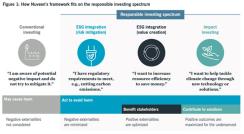
Source: Nuveen, 2021
Another version of the spectrum can be extrapolated from the EU’s Sustainable Finance Disclosure Regulation (SFDR), which classifies investment strategies based on their approach to mitigating or promoting environmental and social characteristics.
A third framework, which Nuveen has adapted for its net impact scoring tool, is the A-B-C approach from the Impact Management Project (IMP) for classifying enterprise contribution.
According to the IMP, A is for avoid harm, B is for benefit stakeholders (including people and the planet) and C is for contribute to solutions. While the original application of this framework is meant for a specific investment, Nuveen elevates the strategy to the portfolio level. To this end, Nuveen defines portfolios that integrate ESG factors (as defined by UN Principles for Responsible Investment) as avoiding harm or benefiting stakeholders, and strategies or portfolios marketed as impact investing (as defined by the GIIN and the Operating Principles for Impact Management) as contributing to solutions.
Managing impact, scoring impact
Managing for impact is different from measuring impact. It is not the amount of impact created or avoided that’s important; rather, it’s the way the impact is integrated and managed in the investment process – and the degree to which impact is systematically considered alongside other fundamental drivers. For ESG integration strategies, impact may be considered only if it’s material to investment performance and to mitigate risk – while impact investing approaches consider impact systematically alongside financial performance with the goal of maximizing both.Impact scoring allows investors to consider potential positive and negative externalities together and compare investments across sectors, strategies and asset classes. It is applicable to all investments, including those without a specific impact objective.
For its global impact private equity strategy and private real assets portfolio (which includes farmland, timberland, agribusiness, infrastructure and energy investment strategies), Nuveen is piloting a score-based approach to serve as a management tool to understand and compare investments based on their net effects on people and the planet (and their alignment with the UN SDGs).
Investments are scored for potential positive or negative alignment with each of the first 15 UN SDGs. Investments gain more or fewer points based on whether the impact is managed intentionally (i.e., impact investing) or as an unintentional externality (i.e., ESG integration), as Figure 2 shows. The sum of each SDG-score is the investment’s net impact score, and the portfolio level score is the AUM-weighted average of all investments’ net impact scores.
Annually updating the net impact score helps monitor changes over time. Companies can improve scores in specific UN SDGs by enhancing ESG management practices, obtaining better evidence of impact and, most importantly, improving performance relative to target indicators. In the same way, a company’s score could decline if ESG or impact performance deteriorates, providing key management information for investors.
Depending on the strategy, investors may decide to set a threshold or other criteria based on the net impact score to inform investment and portfolio management decisions.
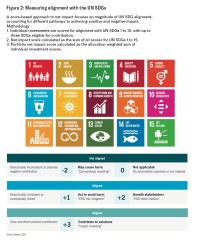
Case example: Analyzing and scoring Samunnati
To give a sense of how the technique works in practice, let’s look a case example of net impact scoring at an individual company level and at a portfolio level. Samunnati is an Indian nonbank financial company held in Nuveen’s global impact private equity portfolio. It provides lending and working capital solutions to various actors in the agricultural value chain, including smallholder farmer-producer organizations and agri-enterprises, both of which have struggled historically to obtain financing.Samunnati’s activities are scored for each of the UN SDGs considered to be material to the investment strategy (highlighted in Figure 3).
- A score of 1 is given for actions that avoid negative externalities with regard to specific UN SDGs as a result of integrating ESG practices. For example, we look for evidence of strong environmental and social lending policies and practices that prohibit lending to businesses that may have a negative impact on the environment or displacement of people.
- A score of 2 is given for actions that create positive externalities for people or the planet. These could include energy efficiency initiatives, employee benefit programs and a diverse customer base (in this case, women).
- A maximum score of 3 is awarded where actions deliver substantial positive changes as a result of the company’s specific intention. In this instance, we look for evidence of impact on the underserved as well as growth in impact over time, such as the share of low-income or rural clients, affordable lending terms or reduction in loan processing time.
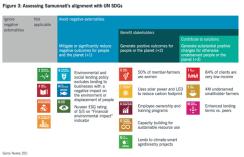
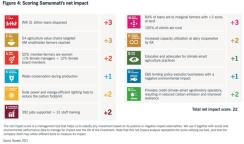
Disclosure: This case study is for illustration purposes only to demonstrate impact score. This information is subject to change without notice and should not be considered investment advice, a recommendation to purchase or sell a specific security or as indicative of the investment performance.
Making comparisons among diverse companies
When companies operate in different sectors and have different impact objectives, it can be difficult to compare ESG and impact performance. The net impact score allows for this comparison, however. Why does this matter?First, it identifies investments that are above or below a certain threshold in relation to delivering impact, potentially aiding decisions about where to invest.
Secondly, it can also reveal best practices that can be shared if a company is a consistently high scorer, or areas in need of change – highlighting scope for improvements in companies where scores can be increased.
Finally, it opens the possibility of understanding net impact alongside traditional operating metrics like revenue, EBITDA or book value, and provides a common quantitative unit of impact to drive analysis between impact and financial performance.
Analyzing impact at the portfolio level
With the ability to compare diverse investments or strategies based on impact with the net impact score, we can assess impact at the portfolio level.Figure 5 presents the net impact score for select real assets strategies within Nuveen’s private real assets platform, all of which integrate ESG factors into the investment process (such as the Samunnati example examined earlier) and some of which also can be considered impact investing.
Implicit in this, of course, is the assumption that not all investments are created equal when it comes to impact. Instead, they exist along a spectrum with a wide range of social and environmental externalities. Conventional investments or strategies that are managed without explicit integration of ESG factors will generate a lower net impact score than more sustainable or impact-focused investments or strategies where impact is core to the investment thesis.
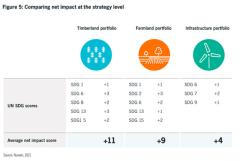
Offering investors a cohesive framework to make better decisions
Institutional investors are paying increasing attention to ESG impact in assessing investments and managing their portfolios. They’re asking for information that allows them to factor positive and negative impacts into their investments decisions as they seek a return on their capital – to improve the quality of decision-making. And they know that identifying compelling impact investments opens up a vast and growing set of opportunities to them.Today, meaningful, impact-related metrics can be applied to broad portfolios and bespoke investment projects, and across the range of private, alternative and publicly listed assets. Incorporating these metrics into portfolio allocation models creates a cohesive framework for investors to optimize impact alongside financial performance – delivering more impactful investments without sacrificing risk return efficiency.
The ability to measure, manage and report the changes that institutional investors desire will be fundamental to their success amid growing demands for transparency and accountability. And it can improve communication between investors, their clients and the companies in which they invest. Nuveen provides institutional investors with these capabilities, as well as access to liquid and illiquid alternative strategies such as real estate, real assets (farmland, timber, infrastructure), private equity and debt, in addition to both traditional and fixed income assets.
To find out more, read Nuveen’s research paper Optimizing for impact with private equity and real assets: A guide to integrating impact into financial analysis of alternative assets, available at nuveen.com
Disclosure:
Responsible investing incorporates Environmental Social Governance (ESG) factors that may affect exposure to issuers, sectors, industries, limiting the type and number of investment opportunities available, which could result in excluding investments that perform well.
Copyright ©2021 Nuveen, LLC. All rights reserved.
AM / ADI Number is GEM-1820264PF-O0921X.






